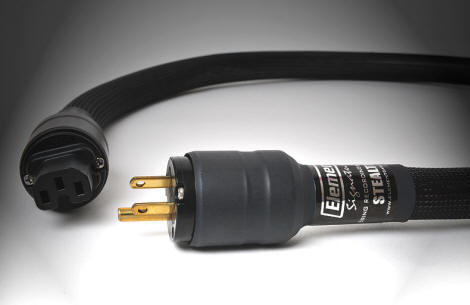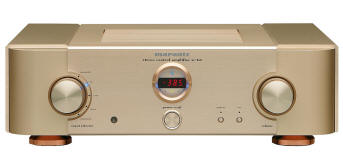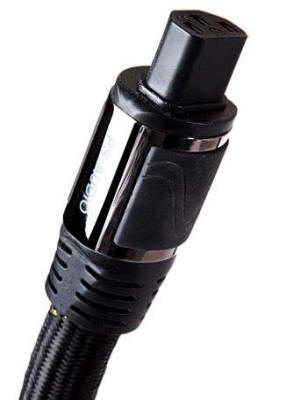Writing about power cords is like drinking air when you are hungry. You can spend a lot of time doing it, but in the end, your efforts will have little effect on your appetite. The reason for my ambivalent outlook on this subject is not that I find aftermarket power cords to be worthless. On the contrary. I find that power cords can have a huge and important and necessary effect on the sound of audio components. As I discuss below, the use of a certain power cord can change the sound of a component from merely good to truly outstanding. No, the real reason for my blasé attitude about power cords is that I have not found “The One” that offers “10 LP” performance with any and all components. Which makes the task of finding the ideal cord for a particular component time consuming and “hit and miss”. Which makes reviews about power cords just about worthless, unless you happen to have one of the components the writer used while writing about the power cords.

In that case, you’re really in luck.
The Stealth “es” power cord from the Element Cables “Signature” product line is quite different from PS Audio’s PerfectWave AC-10, although both are 10 gauge cables. Where the Element cable has a soft and airy feeling, the PS Audio power cable is quite solid. Both are easy to install and bend into place, although the AC-10 takes just a bit more patience. Thankfully, both cables will stay in place after a careful installation. The Stealth has a techflex-type of mesh covering and the PerfectWave comes with PS Audio’s fabric jacket. The latter is more prone to small pulls and snags, although small user-induced defects are less noticeable than with the mesh covering. The Stealth “es” cable lists for $330 for a 1 meter cable and $450 for a 2 meter cable. The AC-10 cable lists for $499.99 for a 1 meter cable and $749.99 for a 2 meter cable.
The Stealth “es” cables uses Wattgate copper connectors. As an upgrade, Element offers a Stealth (without the “es”) power cord for $559/1m. It has Wattgate silver connectors and cryogenics treatment, among other features. PS Audio also offers the PerfectWave AC-12, an 8 gauge cable for $699.99/1m. The PS Audio cables have the company’s proprietary connectors which; a) look great, b) offer a very tight connection, and c) have a removable ground pin on the plug which obviates the need to use cheater plugs.
I evaluated the sound of these cables, along with some DIY 10 gauge power cords and Audience PowerChord e, on Marantz MA-9S2 power amplifiers; Sonic Frontiers Line 2SE+, Sonic Frontiers Line 3, Wyred4Sound STP SE, and Marantz SC-7S2 preamplifiers; Manley Steelhead and AQVOX Phono 2Ci phono preamplifiers; and Apogee Rosetta 200 and Prism Orpheus AD/DA converters.
SIDE NOTE. I am thinking about a new way to recognize outstanding components. A “10 LP” rating already means that the component is of reference caliber and offers very high levels of listening enjoyment. A higher level award would be one that recognizes how much time a component remains in the reference system. After all, it’s no good if it’s gone. If a piece of gear is still in my reference system after a full year, it means it fully and continually passes the Zen Test. Just like people who live in one place for a year, each of these components earn the distinction of being a “Resident”, not merely a passer-by, like Mr. Natural on the Home Page who is merely “just passing through”. Components that would earn this award, as yet unnamed, include the SOTA Cosmos turntable, Miyajima Shilabe phono cartridge, Manley Steelhead Phono Preamplifier, Marantz MA-9S2 power amplifiers, Audience PowerChord e, and Dali Euphonia RS3 loudspeakers.
Differences in the sound of power cables are noticed most readily in the upper frequencies. I listen for the clarity, fine detail and resolution, and decay of the sound instruments such as cymbals and the triangle. Do cymbals sound like metal and not like white noise? Can I easily hear the stick touching the metal disk? Is the sound which follows a clean vibration or is there some haze obscuring the sound? For the triangle, is the initial impulse of the stick cleanly rendered? Can I hear the metal vibrating and is the decay a smooth reduction in volume? Is any frequency in the upper harmonic content emphasized or obscured? Does the decay resolve all the way into silence or is it cut off prematurely?
Less noticeable than the effect on the treble is any change in the depth of the soundstage with a change of power cables. The reproduction of soundstage depth is really little more than an indication of your system’s prowess in low-level resolution, especially in the bass where much of the recording venue’s ambience is found. And as with any other component, the presentation of the power and detail of the bass is also affected by power cables.
The best power cable is the one that locks in with a component and creates a synergistic combination. It will convincingly demonstrate the value of after-market power cables. Until you find this cable and hear it lock in to your system, I doubt that you will believe in the value of special power cables. Until this happens, your opinion will surely be that expensive PCs sound different, sometimes worse, but not necessarily better. And that is OK, but the real problem with the search for the ideal power cord is that you might not get the best performance from a component which you are auditioning. This happened to me with the Marantz SC-7S2 Reference Series preamplifier, the $8000 companion to their outstanding MA-9S2 Reference Series monophonic power amplifiers.

For months, the performance of the Marantz preamp was good, but not up to the level of the power amplifiers. The Line 2 SE+ was easily superior. The issues were predominately in the upper frequencies, where there was a consistent low-level harshness and lack of very low-level resolution. These two negatives are certainly related. I tried most of the power cords above (and some other installation options) without much success in getting the preamplifier to perform as an $8000 component should perform. The last power cord to make its way to the Marantz was the PS Audio PerfectWave AC-10. It took about 2 minutes of listening to completely change my opinion about this preamplifier. The problems I noted above in the upper frequencies were completely gone and the sound was clear, smooth and had very high resolution. NOW I was hearing an $8000 preamplifier. Mission control, we have a lock! None of the other cords were a satisfactory match, but the PerfectWave made this preamplifier sound wonderful. Score one for PS Audio.
The same thing happened with the Element Signature Series Stealth “es” used with either of the Sonic Frontiers tube preamplifiers. These preamps present a good balance between tube (smooth and harmonically rich) sound and solid-state (fast and extended into the low bass and upper treble) sound. With the wrong power cord, the preamps can sound just a bit forward in the upper frequencies. The Stealth “es” matched this character perfectly, reducing that small sense of aggressiveness while affecting the wonderful harmonic precision not one bit. The Stealth “es” surpassed the PerfectWave and Audience PowerChord e on these preamps. The bass was just a bit fuller and more powerful on these components with the Stealth “es” cord, while the PerfectWave offered a very small degree of increased definition in the bass. While it was a simple task to hear individual strings vibrating on an upright bass with either cord, the PerfectWave was just a small bit better. This was barely noticeable on direct comparisons, but I would not choose one cord over the other based on this small character. Score one for Element. The performance of the Stealth “es” offers a spectacularly synergistic fit with the Sonic Frontiers preamps. It should be noted that I bought the cable.
I have been concerned about aging my record collection for the past couple of years. There are about 100 LPs on my personal “A List”, mostly rock/pop from the 70s, 80s and 90s. The stuff I grew up on, can you dig it? Cool, man! They are showing audible signs of wear with the presence of annoying surface noise despite good vinyl hygiene. I embarked – which is truly the correct term for this adventure – on a project to convert these LPs to high resolution digital about a year ago. This has involved four different computers, three different analog-to-digital converters, a shi(p)load of software and other necessary and assorted bits and pieces. As I posted last month on Audio Asylum, here is a summary of my findings to date, and which I am including here because I can.
I compared a 2009 20″ iMac vs. a Windows XP Media Center PC vs. a new “music PC” running Windows 7. In all cases, I used a Prism Orpheus AD/DA Converter with Firewire. A TI chipset Firewire card was moved between the two Windows PCs. Software included iTunes, JRiver, Foobar, Quicktime Player, Logic Express 8, and the new Audacity Beta with a couple of special plug-ins.
– iTunes sounds a lot better on OSx than it does on Windows.
– Windows 7 sounds marginally better than OSx.
– Logic Express 8 is a PIA; far too complex for me.
– JRiver is great, even though it’s $45.
– The Firewire chipset used makes a big difference. Avoid VIA completely and suffer with LSI until you get a card with a Texas Instruments chipset.
– Firewire cables sound different, sometimes by a large margin.
– Firewire is vastly superior to Toslink.
– WAV beats AIF (by a little bit) and FLAC (by a lot). Always start with WAV.
– Rip CDs at 16/44.1 and upsample on playback. I see no advantage to upsampling during the recording/rip. Upsample to a whole-number multiple of 44.1, i.e. to 88.2 or 176.4.
– You don’t need a high powered PC for music. Even an older Pentium 4 at around 2 GHz will be fine. I suggest 2 GB of RAM. The Antec NSK2480 is an excellent case. Very quiet!
– I struggled over the new PC because of the remote control issue. This became moot when I bought a small Virco 8771 adjustable table (under $100 delivered, from schoolroomfurniture.com) and put a mini-keyboard, 19″ Dell Outlet LCD and mouse (extension cables from Monoprice.com) next to my listening seat.
– And finally, these are computers. ALWAYS BACK UP!!! (end of Asylum post)
That is all well and good (and insightful, and reliable, and blah, blah, blah) , but it is relevant because I tried the different power cables on the Prism Orpheus, which is a studio-quality 24-bit 192kHz AD converter, DA converter, phono preamp with RIAA correction, and balanced preamp all in one small $4500 package. (Preview to upcoming review: The Orpheus sounds amazing. Forget analog versus digital. These terms are meaningless with digital components having the quality of sound of the Prism converters. Its versatility makes it a huge bargain. However, the installation and setup are complex: it is not plug and play.) I tried the different cords while recording and also on playback. The best results were obtained, meaning “I like it better”, with my DIY cord which is unique in this company by having a big ferrite clamp on the IEC end.

Even though the Manley Steelhead has a separate enclosure for its sophisticated power supply, the Steelhead’s sound is affected to an easily noticeable degree by the power cable. As noted above, this is most noticeable in the purity and resolution of the upper frequencies. With the Steelhead, the Audience PowerChord e helped it provide the best sound, followed very closely by the PS Audio PerfectWave AC-10. The tradeoff here is that the Audience cable is a bit more forward and offers sharper relief than PS Audio’s cable. The Audience’s character seems to bring the Steelhead’s treble into sharper focus. Therefore, it is a better match for the Steelhead. The Stealth’s slight tendency towards softening the high treble did not work as well with the Steelhead which also is just barely reticent in the highest frequencies. I could easily and happily live with either the Audience or PS Audio power cable on the Steelhead.
The power amplifiers are plugged directly into the wall through a DIY 4 outlet power box which has its own hard wired 10 gauge cord. The front-end components run through a custom power strip which has an IEC inlet for connection to the wall. The front-end power strip is my “DIY Hydra”, which still sounds great 3 ½ years on. Again, each power cord was auditioned in this critical position that powers the line and phono preamps, DAC, tuner, and music computer. (I’ll tell you all about the latter another time.) In this position, the PS Audio PerfectWave offered the purest high frequencies. This is an interesting result because previously I had been using a 2 foot Audience PowerChord e in this position, but felt that the 1.5 meter PerfectWave AC-10 was the superior sounding cable.
I am certain that there are other components that would prefer one of these power cables over the other, or an entirely different cable. I am also certain, given these results, that finding “The One” power cable which would be ideal in all situations would be either impossible, or the greatest good fortune. Of the two cables under review here, I suggest that the PS Audio PerfectWave AC-10 would probably find the greater number of synergistic components. Then again, the Element Stealth “es” might be exactly what you have been looking for. The goal is to find that special, synergistic combination of cables that makes your components really sing in your system. It should go without saying that an even greater goal is to have components which are so neutral sounding and completely immune to the vagaries of incoming power that any decent power cord would work well. Ironically, if you had the perfect component, it would not benefit from the perfect power cable.
The “LP” rating system is being applied a bit differently for power cables. A “10 LP” rating would be awarded to a cable that offered optimal performance with any component, essentially “The One”. While either of these power cables can provide “10 LP” sound with the right component, both cables earned the still-excellent rating below.
Overall Rating: 9.5 LPs
Link to manufacturer’s Web sites:
• Element Signature Cables
• PS Audio
Response from Element Cables:
“Element Signature Cable would like to thank Jerry Seigel for his excellent review of our Stealth “es” power cord and an impressive 9.5 LP rating. I know how difficult it is to properly review cables, and appreciate the time and effort that were put in for this review.
Although Jerry found the PS Audio cord to be sharper on high frequencies. I’d like to point out that our Stealth “es” cord does not roll off high frequencies in any way. The highs of our Stealth “es” cord is smooth and can be considered as more refined if this what the listener is looking for. I’m surprised that Jerry hasn’t found “The One” that offers “10 LP” performance, I’m thinking our ultra-silver Zeus power cord is what he’s looking for.
We look forward to 10 Audio’s review of our Apollo silver speaker cable, a cable that’s been on 10 Audio References page for the past few months. Again, thank you from all of us at Element Signature Cable.
Anthony Wynn
www.elementcable.com
